Museo de las Termas de Caesaraugusta // Caesaraugusta Thermal Baths Museum
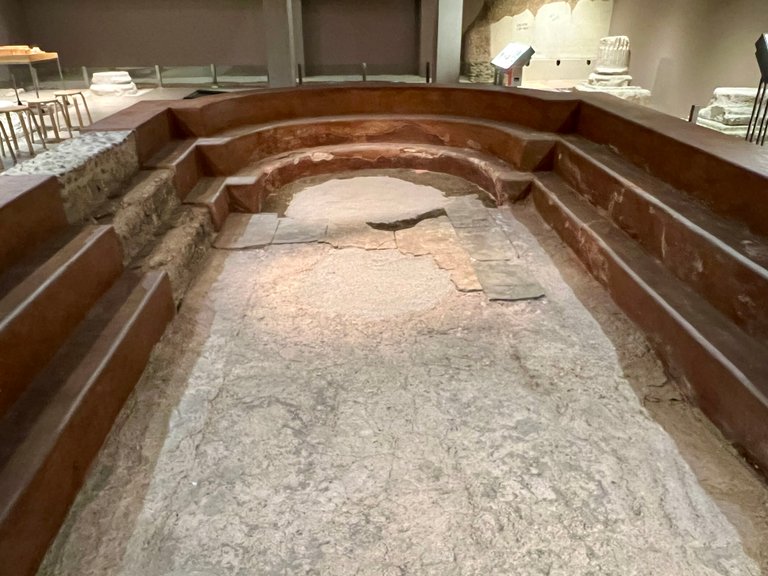

Hola querido hiver.
Con esta publicación cerramos la serie dedicada a la Ruta de Caesaraugusta, un recorrido por los cuatro museos que nos muestran una aproximación a lo que fue la Zaragoza de la época romana, hace unos dos mil años.
Hemos visitado en este blog los museos del Foro, del Puerto Fluvial y del Teatro. Hoy nos alejamos de los grandes espacios y nos adentramos en un lugar donde los romanos buscaban la relajación, el esparcimiento, el contacto social y cuidar de su higiene y salud.
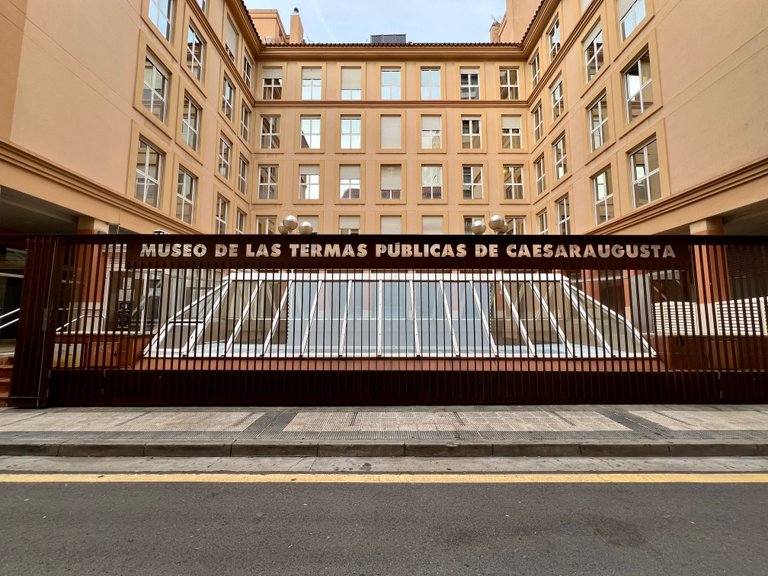
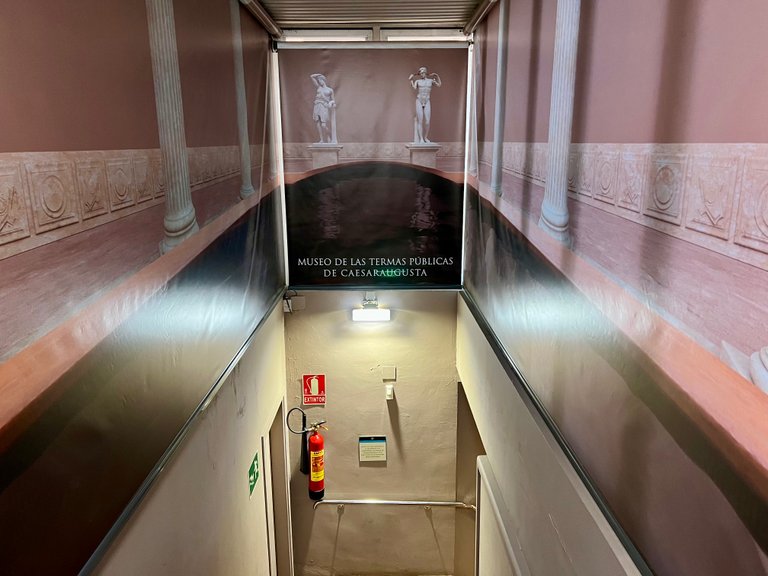
La entrada al museo pasa desapercibida para el peatón que no vaya buscando el museo. Apenas hay una señal en la esquina de una calle que no es principal. Por si esto fuera poco, no hay rastro de edificio alguno que pueda recordar a un espacio cultural, pues la visita se realiza en el subsuelo de lo que hace las veces de patio de luces de una urbanización moderna.
Como ya hemos comentado en anteriores publicaciones, este es un nuevo caso de descubrimiento de restos arqueológicos al excavar para cimentar construcciones nuevas. Gracias a las leyes de conservación del patrimonio se favorece este estudio y difusión de conocimiento que hace más atractiva la ciudad a los turistas.
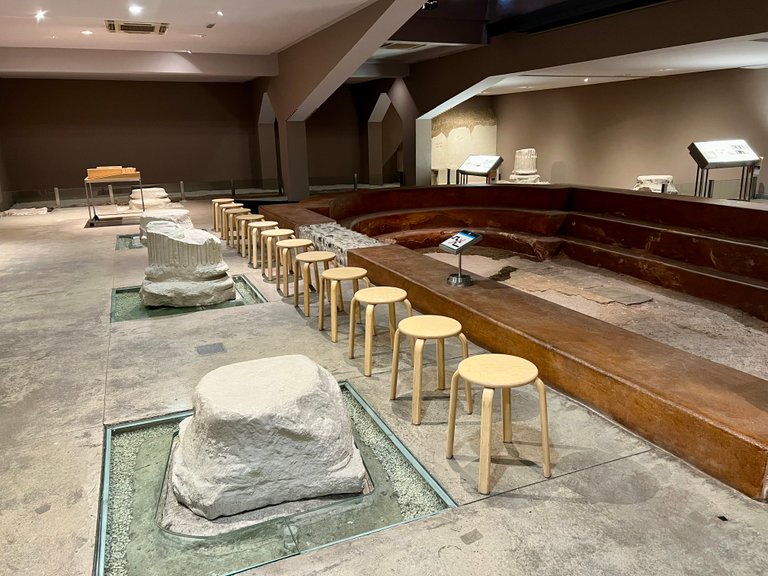

El museo tiene solamente una sala cuya protagonista es una gran piscina. Cada cierto tiempo proyectan un audiovisual que complementa la información de los paneles y carteles. La pantalla se despliega desde el techo cayendo sobre la piscina y los visitantes nos sentamos en esos taburetes que ves en la foto de arriba.
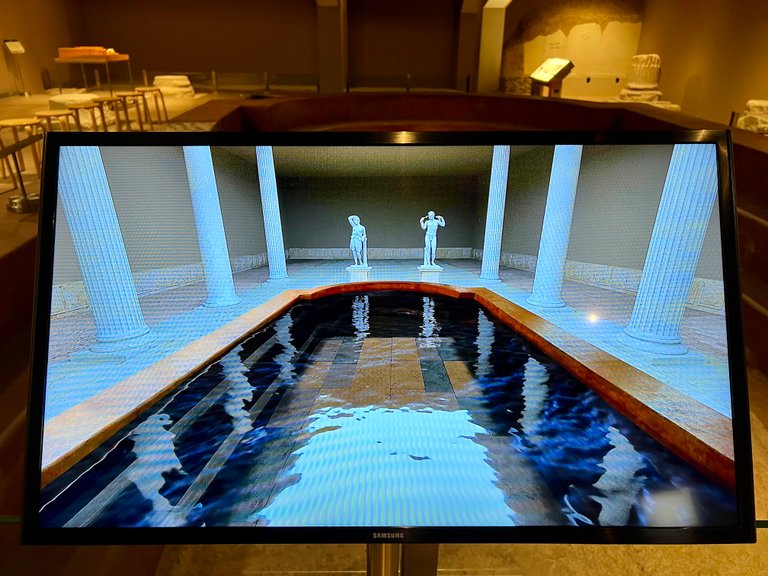
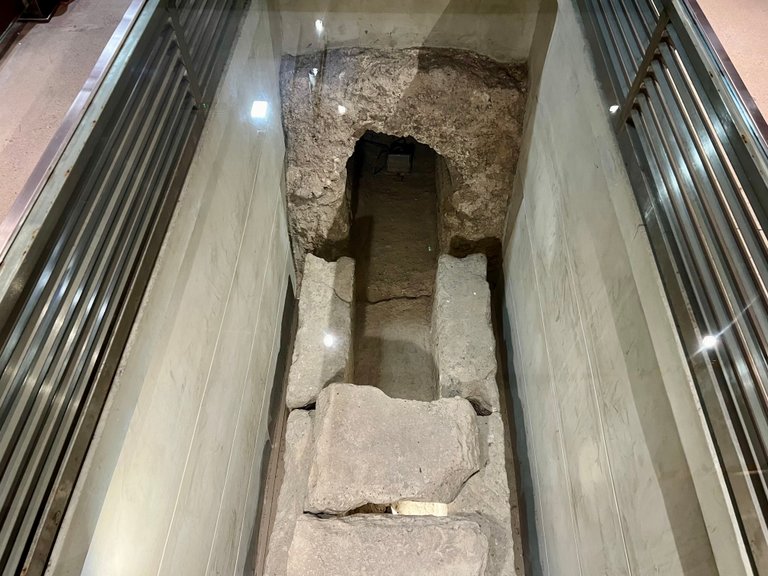
A los pies de la piscina hay una pantalla con imágenes de la hipotética reconstrucción de cómo era lo que tenemos ante la vista. Así es más fácil imaginar las dimensiones de lo que allí hubo.
Por debajo del suelo que pisamos, además, continúa habiendo restos de las canalizaciones de agua y aire que se emplearon en su momento para calentar el agua o deshacerse de ella.
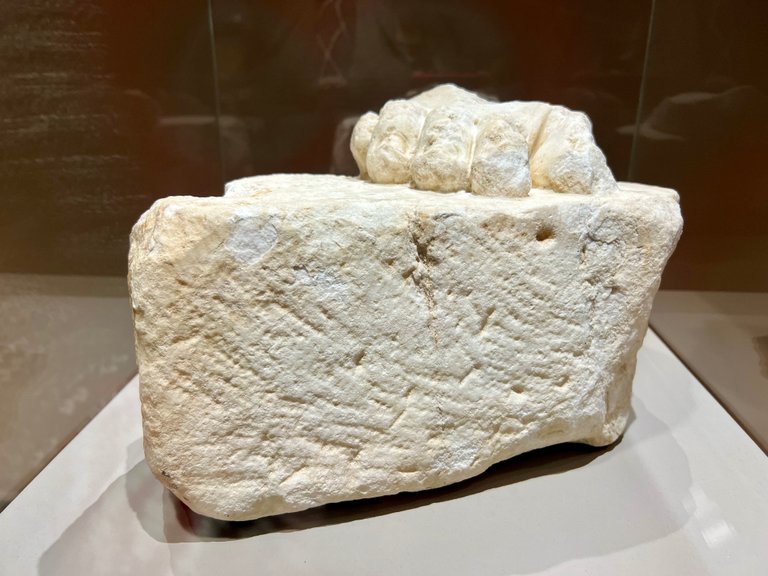
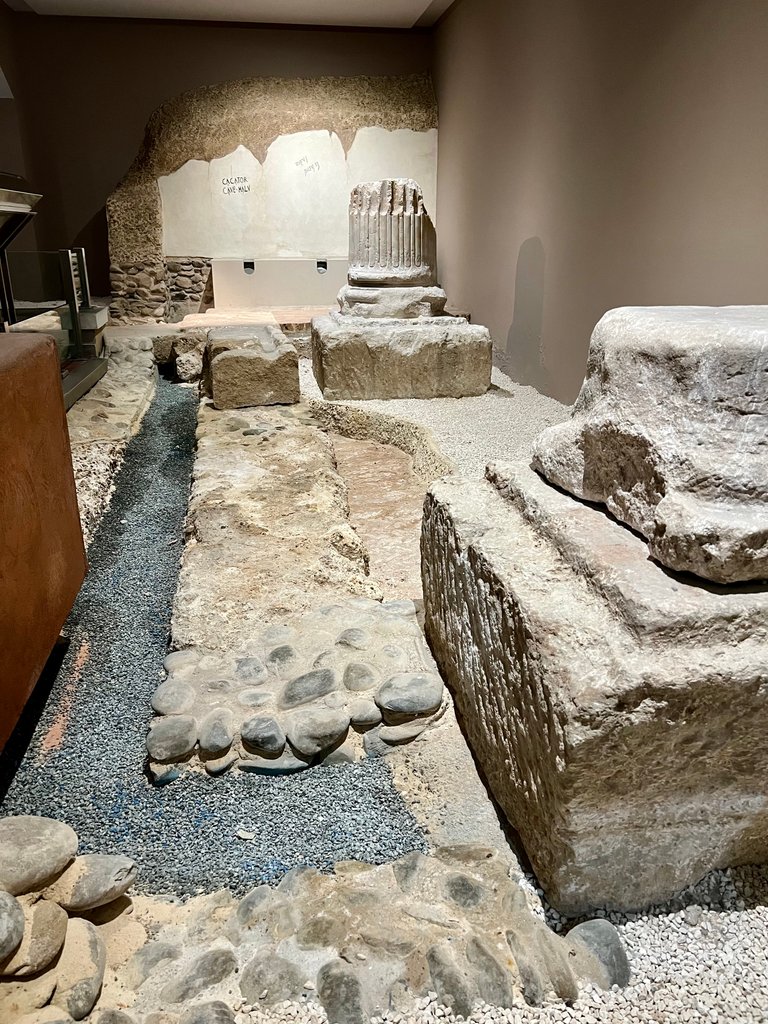
No hay muchas piezas originales, pero una vez más se encuentran partes de cuerpos. Menos mal que son de piedra, jeje. Algunos pies de estatua y de columnas.
También vemos una reconstrucción de lo que fueron unas letrinas que se derribaron para construir la piscina porticada. Su capacidad era de unas 30 personas, lo que no es muy íntimo que digamos para hacer lo que el cuerpo nos pide de vez en cuando...
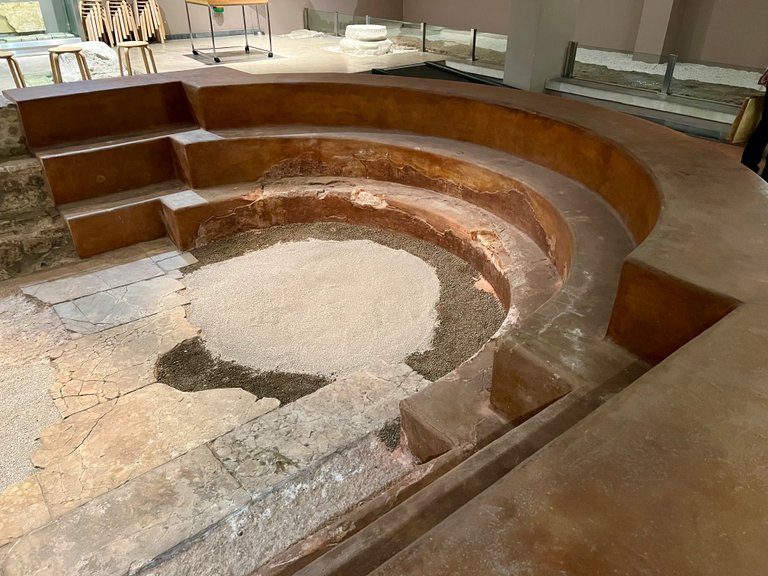
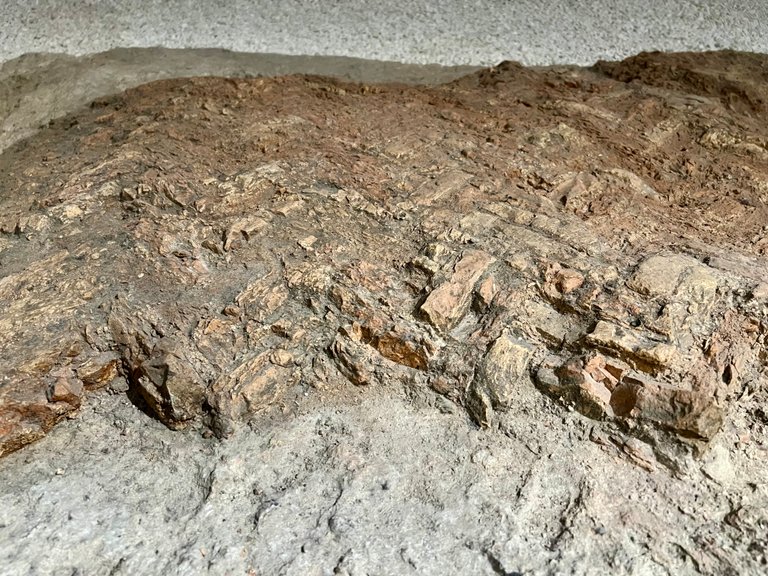
La parte conservada de la piscina permite ver el suelo original y parte de los escalones de acceso. Por otro lado, al fondo de la sala se aprecia lo que fue el pavimento de uno de los pasillos de las termas. Para ser ladrillo ha resistido con honor el paso del tiempo.
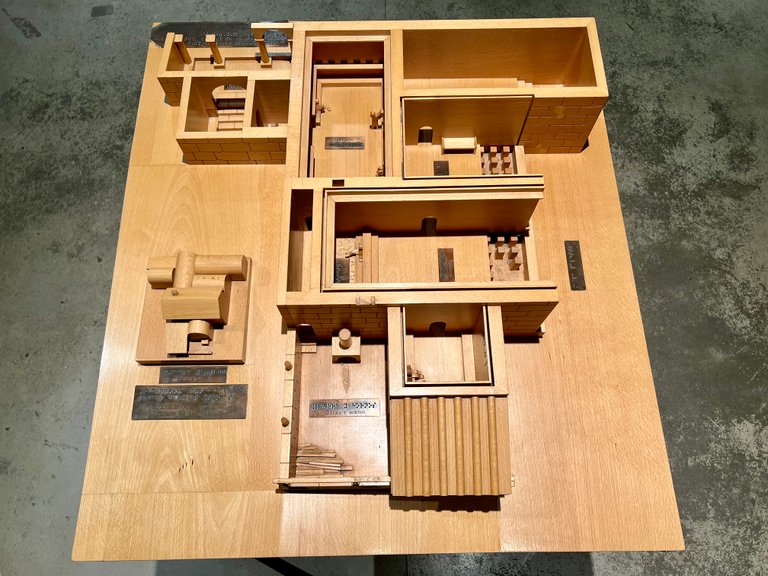

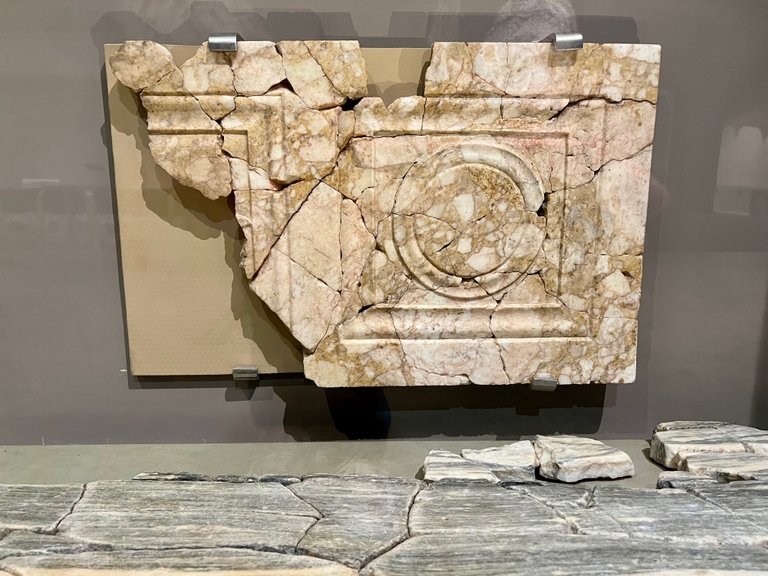
La última parte de la visita es una gran vitrina en la que se exponen losas de mármol originales de las termas. Hay que imaginar todo el suelo y paredes forrados con ese material para darnos cuenta del dispendio que suponía una obra de esta envergadura.
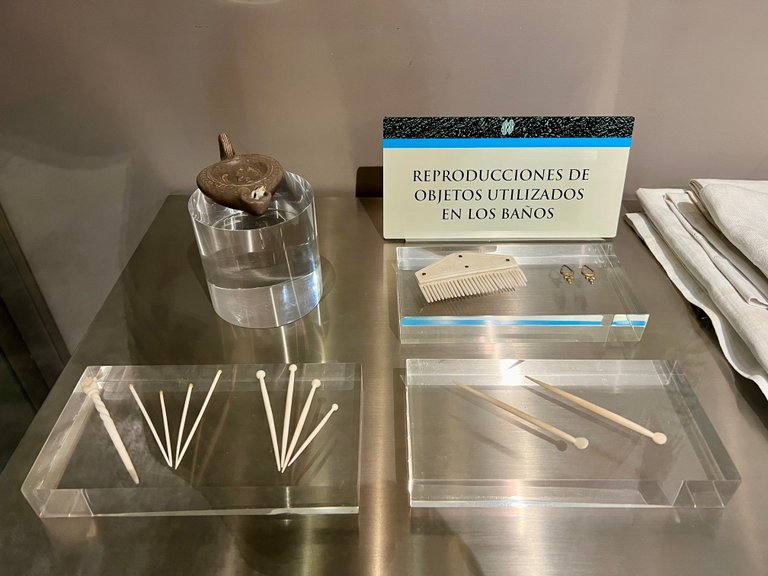


Lo último que vi eran unas reproducciones de los objetos que se utilizaban en los baños. Lo que más llamó mi atención fueron los rascadores con los que se frotaban la piel y las sandalias, que no parecían muy cómodas. También me resultó curioso que llevaban todos los objetos que necesitaban colgados de una anilla, como si fuera la bolsa del gimnasio actual.
Nos despedimos de la Zaragoza romana, al menos por ahora. Seguro que vuelve a aparecer de un modo u otro por este blog.
Hasta la próxima publicación. Mientras tanto, ¡cuídate!
Otras publicaciones de la Ruta Zaragoza Romana:
Museo del Foro de Caesaraugusta // Caesaraugusta Forum Museum
Museo del Puerto Fluvial de Caesaraugusta // Caesaraugusta River Port Museum
Museo del Teatro de Caesaraugusta // Caesaraugusta Theatre Museum

Herramientas: Cámara iPhone 13 Pro, editor de fotos Mac.
Si te gusta lo que publico, únete a mi Fanbase pinchando aquí

©️Copyright 2024 Paloma Peña Pérez. Todos los derechos reservados.



Hi, dear hiver.
With this publication we close the series dedicated to the Route of Caesaraugusta, a tour of the four museums that give us a glimpse of what Zaragoza was like in Roman times, some two thousand years ago.
In this blog we have visited the museums of the Forum, the River Port and the Theatre. Today we move away from the large spaces and enter a place where the Romans sought relaxation, leisure, social contact and to take care of their hygiene and health.


The entrance to the museum goes unnoticed by the pedestrian who is not looking for the museum. There is barely a sign on the corner of a non-main street. As if this were not enough, there is no trace of any building that might remind one of a cultural space, as the visit takes place in the basement of what serves as the courtyard of a modern housing estate.
As we have already commented in previous publications, this is a new case of archaeological remains being discovered when excavating for the foundations of new constructions. Thanks to the laws of heritage conservation, this study and dissemination of knowledge is favoured, which makes the city more attractive to tourists.


The museum has only one room whose protagonist is a large swimming pool. From time to time, an audiovisual presentation is shown to complement the information on the panels and posters. The screen unfolds from the ceiling over the pool and visitors sit on the stools you see in the photo above.


At the foot of the pool there is a screen with images of the hypothetical reconstruction of what we have in front of us. This makes it easier to imagine the dimensions of what was there.
Underneath the floor we walk on, there are still remains of the water and air pipes that were used at the time to heat the water or to dispose of it.


There are not many original pieces, but once again body parts are found. Good thing they are made of stone, hehe. Some statue and column feet.
We can also see a reconstruction of what used to be latrines that were demolished to build the porticoed swimming pool. Its capacity was for about 30 people, which is not very intimate to say to do what the body asks us to do from time to time...


The preserved part of the pool shows the original floor and part of the access steps. On the other hand, at the back of the room you can see what was once the floor of one of the corridors of the baths. For brick, it has stood the test of time with honour.



The last part of the visit is a large showcase displaying original marble slabs from the baths. You have to imagine the entire floor and walls lined with this material to realise the expense involved in a work of this magnitude.



The last thing I saw were reproductions of the objects used in the baths. What most caught my attention were the scrapers with which they rubbed their skin and the sandals, which didn't look very comfortable. I also found it curious that they carried all the objects they needed hanging from a ring, as if it were a modern-day gym bag.
We bid farewell to Roman Zaragoza, at least for now. I'm sure it will appear again in one way or another in this blog.
Until the next post. In the meantime, take care!
Other publications of the Roman Zaragoza Route:
Museo del Foro de Caesaraugusta // Caesaraugusta Forum Museum
Museo del Puerto Fluvial de Caesaraugusta // Caesaraugusta River Port Museum
Museo del Teatro de Caesaraugusta // Caesaraugusta Theatre Museum

Tools: iPhone 13 Pro camera, Mac photo editor.
Translated with DeepL
If you like my content, join my Fanbase clicking here

©️Copyright 2024 Paloma Peña Pérez. All rights reserved.


Congratulations, your post has been added to Pinmapple! 🎉🥳🍍
Did you know you have your own profile map?
And every post has their own map too!
Want to have your post on the map too?
Great exploration miss. I love the swimming part. It's good that people are still able to put together the real pieces instead of replicating everything.
Those shoes are also cool. I bet it was all they've got back then if not the best.
You’re right, the sandals were for rich people in that moment.
I agree with you, I prefer to see fewer things but that are real. To see reproductions you can watch a documentary at home.
Que museo más interesante, hace 2 mil años guaooo donde estaría yo poray que no vi esto..... Si menos mal son de piedra esas partes de los cuerpos porq sino seria un museo del horror.... Eyyy Eyyy esa piscina 30 personas.... Y que es eso que el cuerpo nos pide hacer??? Me queda esa duda.. Y esas zandalias parecen como que la usaban para castigar en verdad que se ven incómodas... Gracias por el paseo... Jjee
A lo mejor estabas en el teatro o dando un paseo por el foro, jajaja. Qué bueno lo de las sandalias, más de una vez he sido víctima de la zapatilla de madre voladora. 🤣🤣
Gracias por tu comentario, me encanta el punto de humor que añades al post. Que no todo tiene que ser serio y sesudo. 😁😘
Very beautiful museum shared by you, very clean and net and so many years old.
Happy to see.
Yes, History is one of my passions and these kind of museums are very interesting to learn. 😃
Awww... The famous roman baths!.... Excellent report, very well structured, very interesting and with very good pictures... It's good to see how the scrapers and sandals have evolved to our times to "more nice things"!... hahaha :))
!VSC
!PIZZA
@jlinaresp has sent VSC to @palomap3
This post was rewarded with 0.1 VSC to support your work.
Join our photography communityVisual Shots
Check here to view or trade VSC Tokens
Be part of our Curation Trail
@jlinaresp ha enviado VSC a @palomap3
Éste post fue recompensado con 0.1 VSC para apoyar tu trabajo.
Únete a nuestra comunidad de fotografía Visual Shots
Consulte aquí para ver o intercambiar VSC Tokens
Se parte de nuestro Trail de Curación
@jlinaresp has sent VSC to @palomap3
This post was rewarded with 0.1 VSC to support your work.
Join our photography communityVisual Shots
Check here to view or trade VSC Tokens
Be part of our Curation Trail
@jlinaresp ha enviado VSC a @palomap3
Éste post fue recompensado con 0.1 VSC para apoyar tu trabajo.
Únete a nuestra comunidad de fotografía Visual Shots
Consulte aquí para ver o intercambiar VSC Tokens
Se parte de nuestro Trail de Curación
@jlinaresp has sent VSC to @palomap3
This post was rewarded with 0.1 VSC to support your work.
Join our photography communityVisual Shots
Check here to view or trade VSC Tokens
Be part of our Curation Trail
@jlinaresp ha enviado VSC a @palomap3
Éste post fue recompensado con 0.1 VSC para apoyar tu trabajo.
Únete a nuestra comunidad de fotografía Visual Shots
Consulte aquí para ver o intercambiar VSC Tokens
Se parte de nuestro Trail de Curación
Oh, yes, those sandals had to be almost torture. 🤣🤣 I'm glad you liked the publication, thank you for the support. ❤️🤗
$PIZZA slices delivered:
@jlinaresp(2/10) tipped @palomap3
!discovery 35
!BBH
@palomap3! Your Content Is Awesome so I just sent 1 $BBH (Bitcoin Backed Hive) to your account on behalf of @jlinaresp. (2/5)
This post was shared and voted inside the discord by the curators team of discovery-it
Join our Community and follow our Curation Trail
Discovery-it is also a Witness, vote for us here
Delegate to us for passive income. Check our 80% fee-back Program
That is a very interesting museum. I wonder what kind of people who use that bath?
I don't think I could jump in and join it in my adult life, but I was used to it when I was a kid. hahah
!VSC !LUV
@ekavieka has sent VSC to @palomap3
This post was rewarded with 0.1 VSC to support your work.
Join our photography communityVisual Shots
Check here to view or trade VSC Tokens
Be part of our Curation Trail
@ekavieka ha enviado VSC a @palomap3
Éste post fue recompensado con 0.1 VSC para apoyar tu trabajo.
Únete a nuestra comunidad de fotografía Visual Shots
Consulte aquí para ver o intercambiar VSC Tokens
Se parte de nuestro Trail de Curación
palomap3, ekavieka sent you LUV. 🙂 (4/5) tools | trade | connect | wiki | daily
Made with LUV by crrdlx.
I suspect that the users of the toilets were the richest. In the audiovisual they said that admission was charged, but also that on some occasions the entrance was free. In those days there would be long queues to enter. 😁
At our adult ages we are more of a spa bath... 🤣
Hiya, @livinguktaiwan here, just swinging by to let you know that this post made it into our Honorable Mentions in Travel Digest #2160.
Your post has been manually curated by the @pinmapple team. If you like what we're doing, please drop by to check out all the rest of today's great posts and consider supporting other authors like yourself and us so we can keep the project going!
Become part of our travel community:
Thank you so much, dear! It’s a great honour to me be mentioned in the Travel Digest!! Big hug. 🤗
Muy bonita la visita 👍, es un poco gracioso imaginarse a las personas con sus anillitas partiendo a la terma 😅, las lozas si debieron ser espectaculares, lindo recorrido el museo a pesar de no ser extenso tiene todo bien distribuido y con un toque elegante y moderno, Saludos 💯✌️👍🌟
La imagen de la gente con sus anillas me parece curiosa, sí. Me encanta aprender ese tipo de detalles de la vida cotidiana.
La piscina con su pórtico al aire y forrada de mármol tenía que ser espectacular. Estos romanos sabían disfrutar de los placeres de la vida… si eras de la clase pudiente, claro. Poco hemos cambiado en ese aspecto y no creo que vaya a cambiar en el futuro. 😅
😅 bueno creo que un baño común para aquella época debió ser un lujo 😄✌️
👏 Keep Up the good work on Hive ♦️ 👏
I like your post. The museum is showing many ancient traditions. I really want to go to this kind of places. Greetings.
Glad you liked it, dear. Yes, museums are like schools for adults hehe. I love to visit them. 😃
Excellent information, thank you, we will make plans to visit Saragosa
That would be great! If you come here don’t forget to let me know and you will have an exclusive tourist guide. 😉